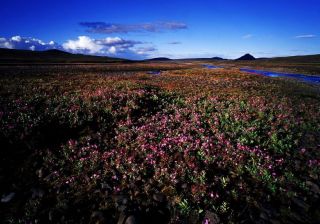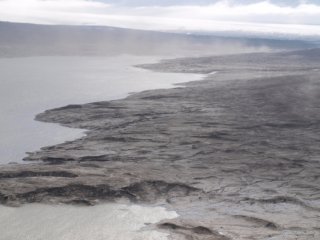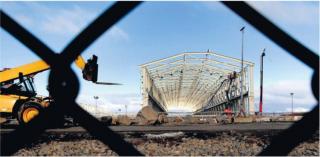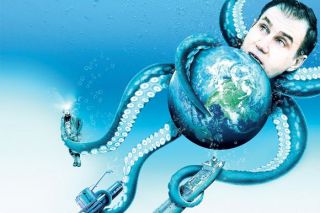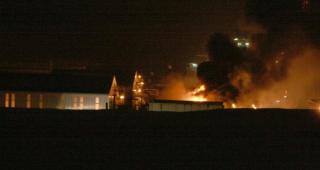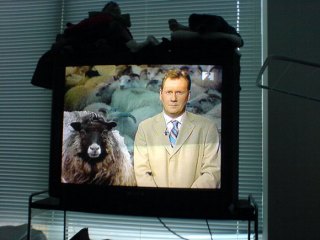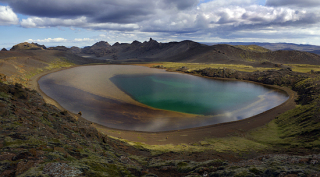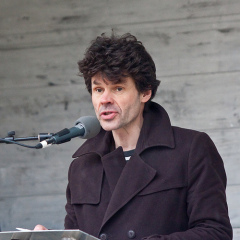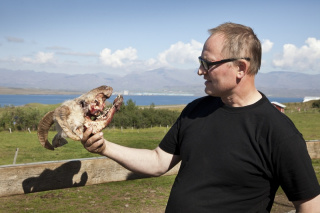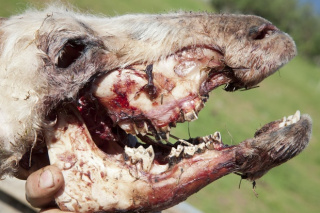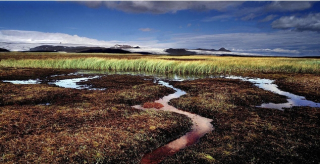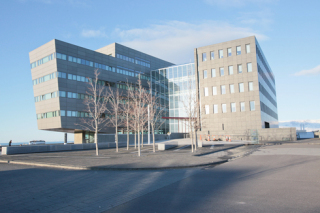'Century Aluminum'
Tag Archive
Dec 09 2011
4 Comments
ALCOA, Century Aluminum, Corruption, Dams, Democracy deficit, Ecology, Economic Collapse, Economics, Helguvík, Impregilo, Jaap Krater, Kárahnjúkar, Landsvirkjun, Media bias, Reykjavik Energy
The profitability of Landsvirkjun, Iceland’s national energy company, is way too low. And worst off is the Kárahnjúkar hydro power plant, Europe’s largest dam, the company’s biggest and most expensive construction. Landsvirkjun’s director Hörður Arnarson revealed this during the company’s recent autumn meeting, and blamed the low price of energy sold to large-scale energy consumers, such as Alcoa’s aluminium smelter in Reyðarfjörður, as one of the biggest factors reducing profit.
These news echo the many warnings made by the opponents of the cluster of five dams at Kárahnjúkar and nearby Eyjabakkar, who repeatedly stated that the project’s alleged profitability was nothing but an illusion, but were systematically silenced by Iceland’s authorities.
Now, as these facts finally become established in the media—this time straight from the horse’s mouth—similarly bad news has arrived regarding another big Icelandic energy company. Reykjavík Energy has failed to make a profit from their 2007 and 2008 investments, effectively making them lose money.
At the same time, new research shows that the environmental impacts of the Kárahnjúkar dams are exactly as vast and serious as environmentalists and scientists feared.
And yet, more dams, geothermal power-plants and aluminium smelters are on the drawing table—presented as the only viable way out of the current economic crisis. Read More
Nov 16 2011
Alterra Power/Magma Energy, Century Aluminum, Energy Master Plan, Geothermal Energy, H.S. Orka, Helguvík, Landsvirkjun, Saving Iceland, Sigmundur Einarsson, Þjórsá
Plans to operate a 250-360 thousand ton aluminium smelter in Helguvík, which has in fact been under construction since 2008, seem ever more likely to be nothing but an inoperable myth of the past, according to environmentalists as well as high ranking officials within the energy sector. Aluminium producer Norðurál (alias Century Aluminum, which already operates one smelter in Iceland), has not only been unable to guarantee the necessary minimum 435 MW of energy but is also stuck in an arbitration conflict with its planned energy supplier HS Orka (owned by Alterra Power, former Magma Energy), concerning energy price. Additionally, environmentalists’ warnings – that the geothermal energy planned to run the smelter can simply not be found – have gained strength and lead to the inevitable question if the damming of river Þjórsá has been planned for Helguvík.
During a recent meeting of chairmen from all the member unions of the Icelandic Confederation of Labour (ASÍ), Hörður Arnarson, the director of the national energy company, Landsvirkjun, said that due to the current situation on international markets it would be enormously difficult for Norðurál to finance the 250 billion ISK smelter project. According to Vilhjálmur Birgisson, who attended the meeting, chairman of the Labor Union of Akranes (near to Grundartangi, where Century’s currently operating smelter is located), Hörður spoke of the Helguvík project’s likelihood as very negligible. Another representative at the meeting, Kristján Gunnarsson, chairman of the Labour and Fishermen Union of Keflavík, stated that when asked about the possibility of Landsvirkjun selling energy to Norðurál, Hörður answered saying that no energy is really available for the project.
While it certainly is true that Landsvirkjun has, especially in the nearest past, had problems with financing, due to the international financial crisis as well as the Icelandic economy’s instability, the latter point – that no energy is actually available for Helguvík – is of more importance here. Environmentalists have, from the beginning of the Helguvík project, stated that the plans to harness energy for the smelter in geothermal areas on the Reykjanes peninsula, are not sufficient, for two reasons. Firstly, as the alleged size of the energy extraction is not sustainable and is more than likely to drain these unique natural areas for good. Secondly, because even if fully exploited, the geothermal areas would not produce enough energy for the smelter. Another energy source will be essential in order for the smelter to operate and even though Reykjavík Energy (OR) has promised Century some energy from a planned enlargement of their power plant in Hellisheiði, the aluminium producer still faces a serious lack of electricity for Helguvík. Read More
Nov 09 2011
10 Comments
Capitalism, Century Aluminum, Corruption, Democracy deficit, Glencore International, Helguvík, Hvalfjörður, Laws, Mining, Pollution, Repression, Workers Rights
A special report for Saving Iceland by Dónal O’Driscoll
Preface
Glencore are the majority shareholder of Century, the owner of one operational and one half-built smelter in Iceland, it’s key operations for aluminium smelting. But who are Glencore and what are the implications for Iceland? This comprehensive article profiles the world’s biggest commodity broker, who’s only comparable predecessor was Enron. The profile covers the reach and grip of Glencore’s domination of metal, grain, coal and bio-oils markets, allowing it to set prices which profit very few and are detrimental to many. It shows the tight web of connections between the major mining companies and Glencore through shared board history and shared ownership of assets, cataloguing key shareholders (and board members) who’s stakes make them larger shareholders than institutional investors in ownership of Glencore. These connections include Rusal’s co chair Nathaniel Rothschild, a financier with a $40m investment in Glencore, and a personal friend of Peter Mandelson (former EU trade commissioner and British politician) and George Osborne (UK Chancellor).
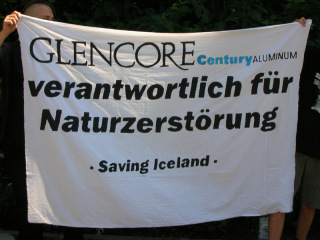
The article details the human rights and environmental abuses of Glencore at it’s many operations, including the 2009 killing of Mayan indigenous leader Adolfo Ich Chamán who spoke out about Century’s activities in Guatemala under CEO-ship of Peter Jones (still a Century board member). It claims that Glencore is higher than most in the running for most abusive and environmentally detrimental mining company, going where lesser devils fear to tread – trading with Congo, Central Asia and embargoed countries such as Saddam Hussein’s Iraq and apartheid South Africa. Glencore founder Marc Rich was involved in trading embargoed Iranian oil, and fled the United States in 1983 accused of insider dealing and tax dodging over Iranian deals, becoming one of the 10 fugitives most wanted by the FBI, until he was pardoned by Bill Clinton. Glencore is still run by two of his main men.
Read More
Pages: 1 2
Nov 09 2011
1 Comment
ALCOA, Century Aluminum, Economics, Greenwash, Rio Tinto Alcan
From The Reykjavík Grapevine
The smallest aluminium smelter in Iceland uses 50% more electricity than all of Iceland’s households and businesses combined, while contributing very little to the country’s GDP. Heavy industry has often been touted by Icelandic conservatives as a cash cow: foreign companies can provide the country with jobs, while utilising Iceland’s green energy to produce aluminium in a cleaner fashion.
While the myth of the “green smelter” has been definitively put to rest, aluminium is still billed by some as being good for the economy. However, Vilhjálmur Þorsteinsson – the chair of a study group assembled by the Ministry of Industry that studies Iceland’s energy use – has come to some damning conclusions about smelters in Iceland.
Iceland’s three aluminium smelters – Alcoa in Reyðarfjörður, Norðurál in Grundartangi, and Rio Tinto Alcan in Straumsvík – consume approximately 13 terawatt hours of electricity. The entire capacity of Iceland’s electrical output is 17 terawatt hours. Furthermore, Straumsvík – the smallest smelter in the country – uses 3.6 terawatt hours. The combined total energy consumption of every home and business in Iceland (apart from the smelters) equals only 2.3 terawatt hours.
At the same time, even the best estimates of what smelters contribute to the economy only put them in the neighbourhood of contributing to 5% of the GDP. Tourism accounts for about the same percentage of the GDP while using far less of the power grid. Meanwhile, Iceland’s service sector accounts for 69.9% of its GDP, and fishing accounts for 12%.
Nov 05 2011
2 Comments
ALCOA, Century Aluminum, Landsvirkjun, Media bias, Reykjavik Energy, Rio Tinto Alcan, Samál (the Icelandic Association of Aluminium Producers)
By Snorri Páll Jónsson Úlfhildarson, originally published in The Reykjavík Grapevine.
Those who are yet to give up on Icelandic media cannot have avoided noticing one Kristján Már Unnarsson, a news director and journalist at TV station Stöð 2. Kristján, who in 2007 received the Icelandic Press Awards for his coverage of “everyday countryside life”, is a peculiar fan of manful and mighty constructions and loves to tell good news to and about all the “good heavy industry guys” that Iceland has to offer.
To be more precise, Kristján has, for at least a decade (and I say “at least” just because my memory and research doesn’t take me further back), gone on a rampage each and every time he gets the chance to tell his audience about the newest of news in Iceland’s heavy industry and energy affairs. He talks about gold-mills when referring to dams built to power aluminium production; and when preparing an evening news item on, say, plans regarding energy and aluminium production, he usually doesn’t see a reason for talking to more than one person – a person who, almost without exception, is in favour of whatever project is being discussed.
After witnessing Kristján’s latest contribution to the ongoing development of heavy industry and large-scale energy production, i.e. his coverage of Alcoa’s recently announced decision not to continue with its plan of building a new aluminium smelter in Húsavík, wherein he managed to blame just anything but Alcoa itself for the company’s decisions, I couldn’t resist asking (and, really, not for the first time): What can really explain this way too obvious one-sidedness, manifest not only in this one journalist’s work but seemingly the majority of news coverage concerning heavy industry? Read More
Sep 11 2011
ALCOA, Alterra Power/Magma Energy, Century Aluminum, Ecology, Economic Collapse, Energy Master Plan, Helguvík, Hengill, Kárahnjúkar, Krafla and Þeistareykir, Krýsuvík, Landsvirkjun, Reykjavik Energy, Rio Tinto Alcan, Sigmundur Einarsson, Þjórsá, Þjórsárver
The equivalent of three Kárahnjúkar dams will be built in Iceland in the near future if the parliament will pass a proposition for a parliamentary resolution on Iceland’s Energy Master Plan, which the Ministers of Environment and of Industry presented three weeks ago. Despite this, Iceland’s energy companies and parliament members in favour of heavy industry have already started complaining – arguing that way too big proportion of Iceland’s nature will be declared protected, will the proposition pass. Among the power plants allowed for in the proposition are three dams in lower Þjórsá, which for years have been a topic of heavy debate and in fact completely split the local community and are more than likely to become the bone of contention between the two governmental parties as the Left Greens (VG) have, along with other environmentalists, voiced their opposition to the damming of Þjórsá.
The Energy Master Plan is a framework programme, meant to result in a long term agreement upon the exploitation and protection of Iceland’s glacial rivers and geothermal areas. Its making, which since 1999 has been in the hands of special steering committiees, established by the two above-mentioned ministries, reached a critical status in July this year when its second phase was finished and presented to the ministers who in mid August presented their proposition for a parliamentary resolution. Before it will be discussed in parliament the proposition will be open to comments and criticism from the public, as well as interested parties, energy and aluminium companies on the one hand, environmentalists on the other. Read More
Aug 30 2011
2 Comments
Bakki, Century Aluminum, Corruption, Democracy deficit, Hvalfjörður, Icelandic Alloys/ELKEM, Krafla and Þeistareykir, Pollution
A broad general reconciliation on environmental and industrial affairs in Hvalfjörður has been completely ignored and stepped on by the Associated Icelandic Ports under the administration of a member of the social-democratic party Samfylkingin. This says Sigurbjörn Hjaltason, farmer in Hvalfjörður, who recently called for an investigation into the possible connection between bone deformities in his sheep’s skulls and an environmental accident at the Norðurál aluminium smelter in Grundartangi in 2006. Sigurbjörn has now raised awareness to yet another potential ecological disaster in Hvalfjörður – a fjord which already hosts two highly polluting factories: an aluminium smelter owned by Norðurál/Century Aluminium and an Elkem ferro silicon plant – as well as the abuse of power entailed in the process.
In a recent article, originally published on news-website Pressan, Sigurbjörn says that before the municipal elections in spring 2009, the community in Hvalfjörður settled upon an agreement about environmental and industrial affairs. But under the administration of Hjálmar Sveinsson (on photo), who is a vice-councilman of Reykjavík for Samfylkingin, a joint venture of several port authorities in the Faxaflói area, titled the Associated Icelandic Ports, is enabling the way for the construction of yet another two factories at the Grundatangi industrial site in Hvalfjörður, where the two aforementioned factories are located. Sigurbjörn describes the whole process as a very dubious one: Read More
Read More
Aug 15 2011
1 Comment
Century Aluminum, Fluoride, health, Hvalfjörður, Pollution
Grapevine.is
A sheep farmer, noticing bone deformities in the skulls of some sheep, believes they may be connected to an environmental accident at an aluminium smelter in 2006, and is calling for an investigation.
Sigurbjörn Hjaltason, a sheep farmer from Kiðafell, told DV that he had noticed quite a number of sheep in his area having difficulty eating, with some dying of starvation as a result. On examining the skulls of the animals, he discovered unusually large swelling of the jaw bones.
This, he believes, is the result of pollution from an aluminium smelter at nearby Grundartangi. In 2006, an accident at the plant caused fluorine to be released into the environment.
Fluorine, which is also present in volcanic ash, when ingested by animals can cause freakish growths in the bones. Sheep that would eat grass that had been covered in volcanic ash would often times grow unnaturally large teeth that prevented them from being able to eat any food at all, resulting in starvation.
The conclusion of the Environmental Office at the time of the accident was the fluorine levels in the surrounding area had doubled.
Sigurbjörn has called for a full investigation, and wants an independent team of scientists to examine the teeth and bones of the sheep that have died.
See also:
More Flouride in Animals Around Aluminium Factories than Elsewhere – Environmental Agency Refuses to Investigate
Pollution from Smelters Damages Teeth in Sheep
Jul 23 2011
Century Aluminum, Democracy deficit, Ecology, Economic Collapse, Energy Master Plan, Guðmundur Páll Ólafsson, Hengill, Kerlingafjöll, Krafla and Þeistareykir, Landsvirkjun, Reykjanes, Rio Tinto Alcan, Torfajökull, Tungnaá, Þjórsá
The making of Iceland’s Energy Master Plan, a framework programme concerning the exploitation and protection of the country’s natural resources, which has been in the making since 1999, has reached a critical state as a report on the process’ second phase was published in the beginning of July. The report includes a list of more than 60 areas, arranged from the perspectives of both protection and exploitation, which is supposed to lay the foundation for a final parliamentary resolution concerning the Master Plan. While those in favour of further exploitation, parallel to the continuous build-up of heavy industry, seem generally happy with the report, environmentalists are both sceptical and critical, stating that the exploitation value was always in the forefront of the process.
Like explained on the project’s official website the process was “split into two phases. The first phase, 1999–2003, evaluated and ranked 20 large-scale hydro-power options, mostly located in the highlands, and the same number of geothermal options in 8 high-temperature areas.” The second phase was supposed to “rank all the options to produce the final result,” including “an evaluation of whether some areas should be conserved completely, without any energy-harnessing activities.” Proposed power projects were said to be “evaluated and categorised on the basis of efficiency, economic profitability, and how they will benefit the economy as a whole,” while the “the impact on the environment, nature, and wildlife” was also supposed to be evaluated, “as well as the impact on the landscape, cultural heritage and ancient monuments, grazing and other traditional land use, outdoor activities fishing, and hunting.” Read More
Jul 16 2011
1 Comment
Century Aluminum, Corruption, Economic Collapse, Economics, Greenwash, H.S. Orka, Hengill, Reykjavik Energy
By Anna Andersen, photos by Alísa Kalyanova. Originally published in The Reykjavík Grapevine.
Overrun by Viking ambition, Reykjavík Energy built headquarters fit for Darth Vader, expanded ambitiously, dabbled in tiger prawn farming and flax seed production, went into the fibre optics business, invested in a new geothermal plant, speculated in places like Djibouti, and finally managed to run itself so completely into the ground that foreign investors will no longer offer the company loans.
In hopes of rescuing its multi-utility service company from the depths of abyss, the city of Reykjavík stepped in this March with a 12 billion ISK (105 million USD) loan, which is nearly its entire reserve fund set aside for the company, but still only a fraction of the company’s massive foreign debt of 200 billion ISK (1.7 billion USD).
With thousands of captive lifetime subscribers and a means of producing energy at very little cost, the company had all the makings of a cash cow. So what happened to Reykjavík Energy, an entity that less than a decade ago was a perfectly viable, municipally owned company providing the city with basic utilities: cold water, hot water and electricity? Read More
